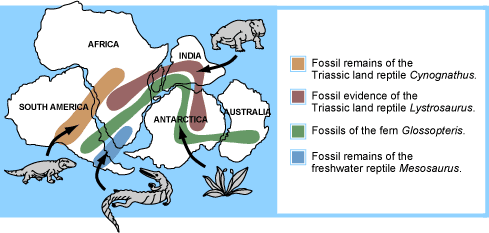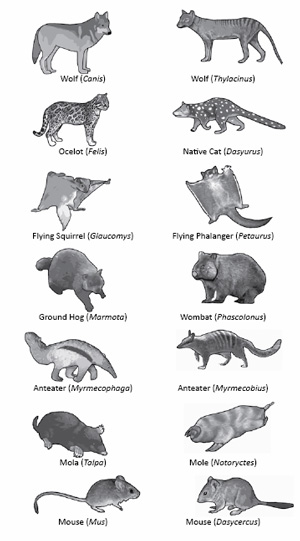Biogeographic classifications are imperative for understanding the distribution of fauna and flora in different regions. Biogeographic distribution has become critical in comprehending causative factors associated with evolution based on elements of geologic phenomena or dynamics of biological orientations.
Plate tectonics
The tectonics has been recognised as a major element that influenced the geographical distribution of organisms on the global basis. The biogeographic regions, as recognised by Wallace, have nearly corresponded to the arrangements of the Earth’s continents. Later studies have revealed that biogeography becomes more dynamic as changes occur over time. For instance, a geologist, Alfred Wegener, discovered that some identical fossil organisms were found in different sides of the Atlantic (Biogeography: Wallace and Wegener n.d). Based on this observation, the geologists acknowledged that the ocean was far too wide for these organisms to have crossed independently. Therefore, Wegener proposed that different continents were once connected. After the 1960s, geologists focused on understanding the ocean floors. Consequently, they determined that plate tectonics was responsible for the continental drift.

Today, biogeographers had recognised that different continents collided, thus organisms could mix, and when continents parted, they moved with new organisms. Hence, different continents, such as “Africa, South America, Australia, and New Zealand, for example, were all once joined into a supercontinent called Gondwanaland” (Biogeography: Wallace and Wegener n.d). These continents separated gradually, one after another, for example, Africa was followed by New Zealand, and Australia and South America were the last to drift. The evolutionary study of midges (insects) depicts similar patterns. There was marked resemblance between midges found in South America and Australia relative to those found in New Zealand. Still, the midges found in these three continents were more closely related compared to African species. From these observations, geologists used midge species to understand effects of plate tectonics on biogeographic distribution that took place over million years ago.
Evolution
Darwin’s theory of evolution states that organisms developed from “small, shrew-like creatures around 100 million years ago” (Statham 2010, p. 82). Other studies, however, have shown that some elements of biogeographic distribution could be extremely intricate to explain based on the evolution theory.
It is claimed that the noted organisms started to evolve into “the marsupials found in Australia and the placentals found in Europe and other parts of the world” (Statham 2010, p. 82). There are notable features between these creatures, for instance, their reproductive features are significantly different, but they are the same with regard to other features.

For instance, some European placental dogs, timber wolf (Canis lupus), Australian marsupial dogs, and the Tasmanian marsupial wolf (Thylacinus cynocephalus) almost share similar skeletal features. In addition, other species of placental and marsupials, which apparently evolved differently, have shown the same features.
There are three critical areas of concerns for evolution. The environment could not adequately explain the similarity or differences because some similar environments could have completely diverse species. There is also closer affinity associated with the same species in one continent compared to other species on different continents. Geographical barriers are responsible for division of various groups of species. In addition, there are relationships between the extent of variations and rates of migration based on abilities to disperse across geographical barriers.
Darwin’s theory proposed a central place of origin of species. This requires discontinuous distributions to be analysed and explained. The theory recognised that species isolation could lead to changes, but species dispersal across geographical barriers must be understood. The environment, as previously mentioned, could have influenced distributions, changes in climate and geological conditions, which must have influenced migrations by either restricting or facilitating migrations. Darwin wanted to explain the concept of a priori in dispersal, but accidental dispersal was not common, and therefore one could predict specific distribution patterns in some cases.
Geographical barriers associated with glaciations could have led to isolation. It is difficult to explain types of species range found in freshwater because of its isolation. However, it has broader distributions relative to terrestrials. In most cases, animals, particularly birds, are responsible for distribution of freshwater organisms. At the same time, Darwin studied various distribution patterns found in oceanic islands.
Vicariance and dispersal
Vicariance reflects fragmentation of the environment through tectonic plates. This is responsible for facilitating biological evolution by splitting taxon into isolated subpopulations. This results in vicariance biogeography. It is not similar to dispersal. It was observed that disjunct (isolated) patterns occurred due to transformations compelled on initially continuous distributions. These could have been caused by continental shifts or formations of mountains among others. For instance, the shift of Gondwanaland could help to explain the distribution of species in Australia and other continents.
The concept of vicariance biogeography is also useful for understanding disjunct distributions by disappearance of intervening populations. Dispersal and later vicariance could be suitable for providing accounts on certain patterns of distribution. However, patterns could be vicariant if the dispersal caused continuous distribution of species as shown in the case of distribution of Camelidae. Further, a study by Mitchell et al. (2014) showed that the results from the New Zealand kiwi and basal ratite lineage of ostriches “strongly contradicted continental vicariance and instead supported flight dispersal in all major ratite lineages” (p. 898).
Dispersal was based on the assumption that several species could disperse over vast distances due to environmental factors, which could not support species reproduction or survival. There are cases of recent dispersals, for example, the Krakatoa eruption of 1883 that eliminated all the species on the island, but after half a century, there were forest inhabitants that obviously emanated from Sumatra and Java (Fitch 1997). There are many modes of dispersa,l such as corridors, but different species have different abilities to disperse greatly over continents.
Australia’s biogeographic regions
Australia has eight terrestrial habitats that cover a land mass of 89 bioregions and over 400 subregions (Ebach 2012). These regions have various groups of interrelated ecological units that occur in different patterns throughout these bioregions (Ebach 2012). Bioregions consist of vast, geographically unique locations with major features reflected in geology, landform patterns, ecological elements, organisms and climate.
Spencer and Gillen (1912) proposed Australian biogeographic regions as follows:
- Eyrean Subregion: Arid centre of the continent (white) blank
- Marginal Subregions
- Westralia (blue): shares disjunct plant species with South Africa
- Torresian (green)
- Bassian (fuscia): shares disjunct plant species (e.g., Nothofagus) with South America (& New Zealand & New Caledonia)

Today, Australia has defined its bioregions based on the Interim Biogeographic Regionalisation for Australia (IBRA) (Ebach 2012). This is a tool, which guides processes of identifying land areas for reservation. Initially, the IBRA was used to determine the terrestrial areas and ecoregions within Australia. Later works led to further subdivision of Australian landscape based on the IBRA outcomes.
Australia has used different vegetation species and land systems to determine regions and subregions as biogeographic regions. Hence, the outcomes have been useful for identifying various ecosystems within Australia. Today, however, Australia does not have a reliable mode of classifying and plotting local bioregions with the exception of some few jurisdictions.
Australia has demonstrated much focus on its biogeographic regions by constantly updating IBRA based on new scientific evidence. Therefore, new biogeographic regions are continuously added and new protected areas are marked. As such, Australia has a framework for monitoring and evaluating changes and progresses towards the creation of biogeographic regions.
By using data gathered from the biogeographic regions, Australia can measure and understand changes in its ecosystems and levels of protection. These issues have been critical for the government’s planning and prioritisation of resources.
Australian Taxa
Australia remains a single region with unique biodiversity and an incredible natural ecosystem, responsible for diversification and speciation. Consequently, it has attracted much attention from researchers interested in speciation (Mitchell, et al. 2014).
It is believed that the Gondwanaland persisted over several years and later provided opportunities for different species to spread across it. Later when the Gondwanaland drifted, it took place in stages, but finally, the continent of Australia became isolated from the other two, South America and Antarctica.
The available evidence demonstrates that as Gondwanaland was shifting, many major global climatic changes also took place simultaneously. These changes as noted in the environment had significant effects on Australian environment as evidence from fossil record indicates.
There were also notable changes on Australian taxa. Some species effectively adapted to the new environmental conditions than the others, continued to exist and later reproduced with genetic features passed to other generations.
Geologists have noted contributions from paleontology and evidence from previous ecosystems, which are critical for understanding how present actions could influence later Australian taxa.
As the ecosystem transformed so did the distribution of Australia fauna and flora. Specifically, species that could thrive in warm, dry conditions in new environmental conditions survived. On the other hand, organisms that could not adapt to such ecosystems became extinct or managed to survive in extremely harsh conditions. Available examples are notable in areas like Naracoorte and Riversleigh. Fossils discovered from these regions of Australia showed that climatic conditions had changed to warm, dry and hot. Evidence from Australia fossils, therefore, show that the distribution of Australian taxa transformed based on the prevailing environmental conditions and changes. For instance, certain species of plants and animals, which depict adaptation, are notable in Australia. There are many species of acacia plants and eucalyptus plants, which have shown significant adaptation to Australian environment. Today, acacias can be found in hot arid areas. They are common in coastal heaths, arid areas, tropical rainforests and even in sand dunes. On the other hand, eucalypts are common in hot arid areas in woodland and forests.
There were also three common mammals found in Australia after the continental drift. These included placentals, marsupials and monotremes (Statham 2010). Marsupials became the most adaptable unique species in the warm, dry ecosystems of Australia.
Reference
‘Biogeography: Wallace and Wegener’, n.d., Understanding Evolution, 2014. Web.
Ebach, M 2012, ‘A history of biogeographicalregionalisation in Australia’, Zootaxa, vol. 3392, pp. 1-34.
Fitch, DH 1997, Darwin’s evidence for evolution: Biogeographic distributions, Web.
Mitchell, K, Llamas, B, Soubrier, J, Rawlence, N, Worthy, T, Wood, J, Lee, M, Cooper, A 2014, ‘Ancient DNA reveals elephant birds and kiwi are sister taxa and clarifies ratite bird evolution’, Science, vol. 344, no. 6186, pp. 898-900. doi: 10.1126/science.1251981.
Spencer, W & Gillen, F 1912, Across Australia, vol. 2, Macmillan, London.
Statham, D 2010, ‘Biogeography’, Journal of Creation, vol. 24, no. 1, pp. 82–87.